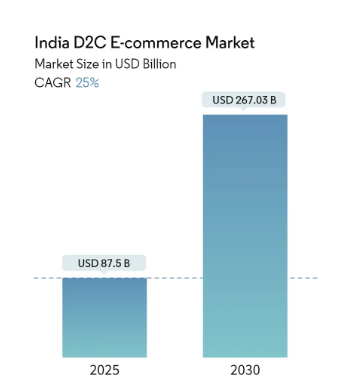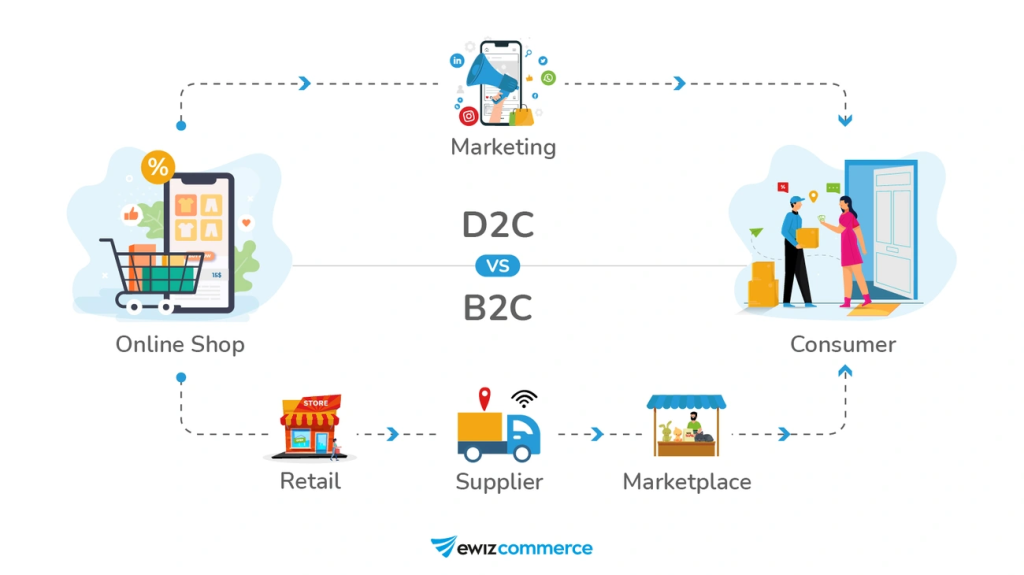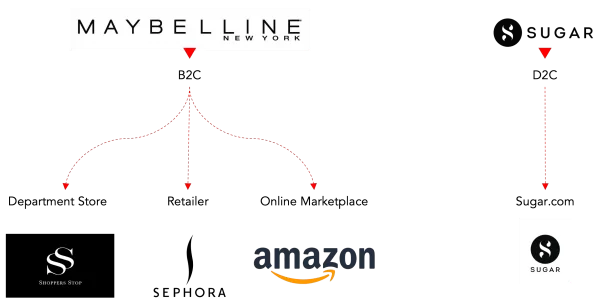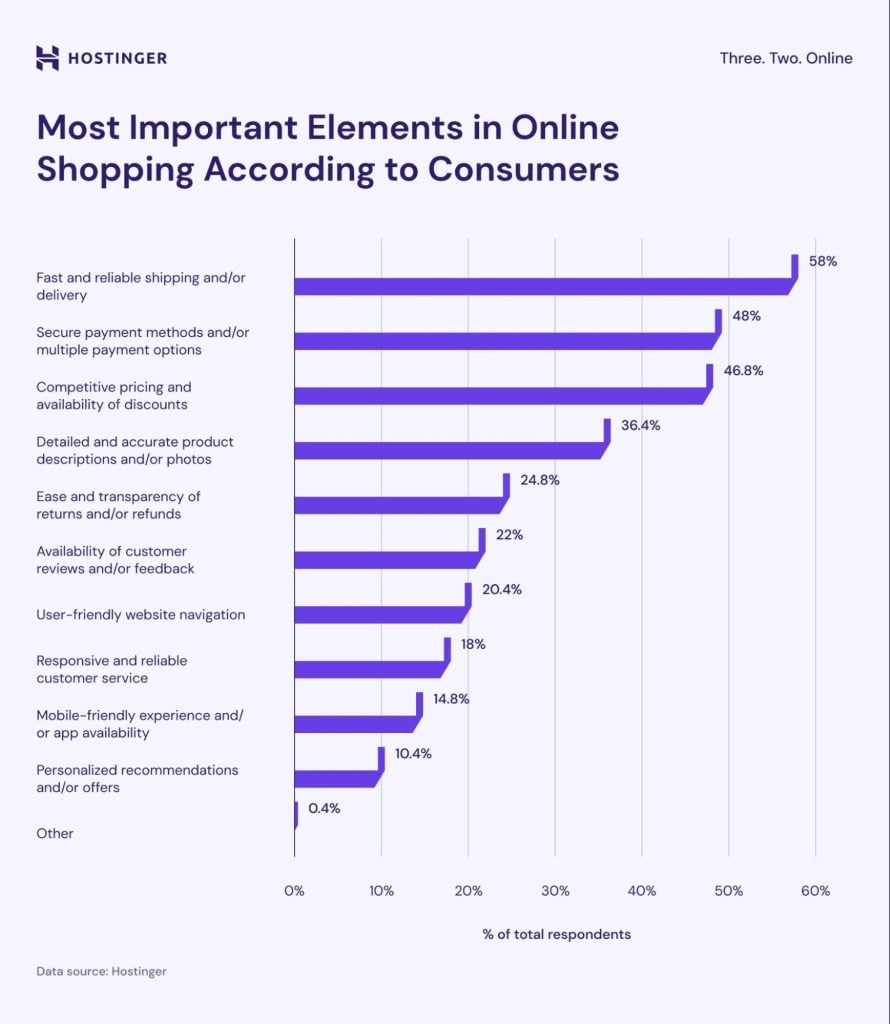D2C vs Marketplace: Which Business Model Should You Choose in 2025

23rd May 2025 / in SEO / by Ruturaj Kohok
- Reading time: 11 mins 02 Sec
D2C is changing the e-commerce world at an incredible pace. This makes the choice of business model crucial for success.
Did you know? India now has more than 800 direct-to-consumer brands, and their market size will be USD 80 billion in 2024.

Source: Mordor Intelligence
The Indian D2C market will reach USD 267 billion by 2030 and grow at a remarkable 25% CAGR.
Now, the D2C business model delivers significantly higher profit margins than traditional retail channels. Yet marketplace models remain the consumer’s preferred choice.
Ever wondered why it is so? The reason is simple!
The e-commerce marketplace platforms like Amazon and Flipkart offer a number of brands and products all in one place!
This means… less hassle, less work, less browsing, and less confusion!
But, from the perspective of a business owner, which model should you go for?
Let us help you make this critical business decision for 2025. We will analyse the pros and cons of each approach.
This analysis will help you choose the model, or combination of models, that suits your business goals perfectly!
Let’s dive in!
Understanding the D2C and Marketplace Models

Source: Ewiz Commerce
All business models compete fiercely in today’s digital world. You need to understand everything in D2C and marketplace approaches before making your strategic choice.
What is a D2C business model?
The D2C business model lets brands sell products straight to end customers without middlemen like wholesalers or retailers.
Companies control the entire customer experience—from manufacturing to marketing, sales, and customer support.
Key characteristics of D2C brands:
- Brands fully control messaging, design, and customer experience
- Direct ownership of customer relationships and first-party data
- Front-loaded but predictable costs (website development, platform subscription, payment gateway fees)
- Higher profit margins without middlemen markups
Businesses with D2C capabilities show higher year-over-year share price growth compared to non-D2C businesses.
Let’s take an example:

Source: Statista
Brands like Nike illustrate this approach. Until 2024, it has grown to $21.52 billion solely through D2C marketing.
How does an e-commerce marketplace work?
An online marketplace is an e-commerce website where multiple third parties provide product information. These platforms connect buyers and sellers.
The marketplace operator processes transactions while participating retailers handle fulfilment.
Marketplace mechanics:
- Sellers list products with prices and information
- Platforms take commissions (typically 10-20% of gross merchandise value)
- Marketplaces handle payment processing, fraud protection, and often logistics
Amazon, eBay, and Flipkart lead the pack of marketplace platforms. These platforms bring massive traffic but limited control.
Key differences between D2C and Marketplace models
The biggest difference between D2C and marketplace models lies in customer relationship ownership.
#1 Customer relationships
D2C brands build direct customer relationships and access valuable data. This enables individual-specific marketing and customer support.
In marketplaces, the platform owns most customer relationships. Sellers get limited access to customer data.
#2 Branding
D2C gives better brand storytelling options. Marketplaces restrict listings to rigid templates for comparison shopping.
Notwithstanding that, marketplaces give instant access to huge audiences, make logistics easier, and excel at price-sensitive acquisition.
Smart brands now use hybrid strategies. They utilise marketplaces to get discovered while guiding customers to their D2C platforms for deeper involvement and better margins.

Source: Piwheel
Sugar Cosmetics started as a D2C brand that sold its products entirely through its channels. Since then, Sugar Cosmetics has branched out into other marketing channels as well.
Meanwhile, Maybelline, an already established cosmetics brand, has multiple channels of marketing, of which, online marketplace is one.
Which business model should you go for?
Your product’s nature helps determine the best business model for you. Each category shows unique selling patterns that work better with marketplace platforms or direct channels.
D2C Model
D2C business models excel when products need detailed education, customisation, or careful buyer consideration.
High-involvement purchases benefit from direct brand relationships. D2C offers these key advantages:
- You retain control over product education and brand storytelling
- You can run small-scale market tests for specific demographics
- You get direct consumer feedback to improve products
- You earn higher profit margins to reinvest in product development
Marketplace Model
Fast-moving consumer goods (FMCG) and impulse purchases do well in marketplace settings. However, quick commerce platforms have altered the map of this sector.
Going for Flipkart or Amazon marketplace allows you access to their massive customer base and their buying habits.
You can get prompt visibility without really needing a website.
You can go selling on marketplaces if you want quicker recognition and to improve sales without having to invest a lot in the initial stages of your business.
Customers prefer e-commerce marketplaces as they offer competitive pricing, fast and reliable shipping, and the convenience of finding different brands under one roof.

Source: Hostinger
Check this out: 58% of online shoppers prioritise reliable shipping services and fast delivery when going for an online purchase, while 46.8% look for competitive pricing.
Hybrid approach: When to combine both models
Smart brands now use both channels in their strategy. More than half of the brands on Amazon use a hybrid model that combines a first-party (1P) sales model and a third-party (3P) sales model.
The hybrid approach works well when you need to:
- Spread risk across multiple sales channels
- Use marketplaces to acquire customers while keeping D2C for loyalty
- Test seasonal products through 3P while distributing staples widely
- Balance reach through online marketplaces with D2C margins
You can determine the right mix based on your business goals.
D2C vs Marketplaces: Different Approaches to Customer Engagement
Customer relationships can make or break e-commerce businesses in 2025. Brands that connect well with their customers substantially improve their long-term loyalty and profits.
Let’s see which business model has more control over their operations and offers a better customer experience.
Personalisation
D2C brands excel at creating tailored experiences throughout the customer’s shopping journey.
These brands own all touchpoints directly and can customise everything, right from product suggestions to after-purchase messages.
Marketplaces limit personalisation options because of their template-based environments.
And it goes without saying, better personalisation leads to real results.

Source: Xpressdocs
Research shows 80% of customers choose businesses that send them highly tailored offers and messages.
Online D2C stores give brands powerful ways to personalise:
- Custom UI/UX that matches the brand’s look and feel
- Rewards based on each customer’s shopping habits
- Product suggestions that help customers spend more
Lately, with the rise in artificial intelligence, AI-powered personalisation has been on the rise to offer tailored experiences like never before!
Customer data access
D2C brands‘ biggest advantage comes from their data collection methods.
These direct customer connections give access to first-party data, which, in simple words, is information that comes straight from customers instead of middlemen. E-commerce marketplaces keep most of this data to themselves.
First-party data has become more valuable now that privacy rules are stricter and third-party cookies are going away.
Many fast-growing companies now focus on first-party data to create personalisation strategies.
This fundamental change helps D2C businesses create detailed customer profiles and find valuable customer groups to target.
Post-sale service and loyalty programs
Loyalty programs are crucial to D2C success. Brands use analytics and machine learning to understand shopping patterns better, which helps create targeted rewards.
These programs build emotional connections that bring customers back and turn them into brand promoters.
D2C brands also control every part of the after-purchase experience, from customer service to returns.
This direct connection builds trust because customers get better support when dealing with brands directly instead of going through marketplace middlemen.
Analysing the financial aspect of your e-commerce brand model
Business leaders need to understand the economic trade-offs between D2C and marketplace models to make smart business decisions. The success of any e-commerce strategy depends on its financial performance.
Let’s understand the financial aspects of choosing each of these business models.
Gross margins
D2C brands earn SIGNIFICANTLY higher profit margins than marketplace sellers. They achieve this by cutting out the middlemen.
Comparatively, marketplace transactions do not yield as appealing results.
Yes, it is because marketplace operators must limit their commission rates to keep vendors interested. This creates a profit ceiling that D2C businesses don’t have to worry about.
Customer acquisition cost: Paid ads vs built-in traffic
Customer acquisition costs work very differently between these models.
D2C brands need heavy investment in customer acquisition, but their average customer acquisition cost (CAC) is *MUCH* better than traditional e-commerce brands.
Marketplaces give you quick access to customers, but at a cost:
- Most marketplace sellers keep ad spending low
- D2C success needs SEO, paid ads, and organic social media
- Search traffic converts 2-3x better than paid traffic
D2C vs. Marketplace: Selecting the Business Model That Supports Your Objectives - Our Final Thoughts
The choice between D2C and marketplace models depends on your business needs, goals, and resources.
D2C offers the most important advantages in brand control, customer data ownership, and profit margins. It also gives you complete control over your customer experience with personalisation capabilities that marketplace sellers cannot match.
Marketplaces still dominate consumer shopping habits with good reason, too. Their built-in traffic, proven trust, and simplified buying process make them powerful channels. New brands seeking immediate visibility find them particularly valuable.
Smart brands now accept a hybrid approach. They can test products through marketplaces before scaling successful items via direct channels.
This balanced strategy lets businesses use online marketplaces to acquire customers while maintaining D2C channels for deeper relationships and higher margins.
Take time to assess your current capabilities, resources, and long-term vision honestly. Start with the model that lines up with your immediate strengths, then expand as you gain experience.
Note that successful e-commerce strategies adapt to changing market conditions and customer priorities over time.
Looking for a D2C set-up from scratch or marketplace listings that drive results? Contact us for e-commerce marketing strategies that scale up your business.
FAQs:
D2C (Direct-to-Consumer) brands sell directly to customers, offering higher profit margins and greater control over brand messaging and customer experience. Marketplaces, on the other hand, provide access to a larger customer base but with lower margins and less control over the brand experience.
For new brands, marketplaces often provide an easier entry point due to built-in traffic and lower upfront marketing costs. However, D2C can be advantageous for brands with unique products or those prioritising brand control and higher profit margins.
D2C brands typically enjoy higher profit margins compared to other e-commerce marketplaces because they exclude all intermediaries such as wholesalers, retailers or any marketplaces, leaving them with a larger chunk of profit from each sale. This also eliminates the commission charged by such intermediaries, allowing them stronger profit margins.
Yes, many successful brands employ a hybrid approach. This strategy allows them to leverage marketplaces for customer acquisition and visibility while maintaining D2C channels for deeper customer relationships and higher margins.
D2C brands have direct access to first-party customer data, allowing for more personalised marketing and customer experiences. Marketplace sellers typically have limited access to customer data, as the platform primarily owns these relationships.































